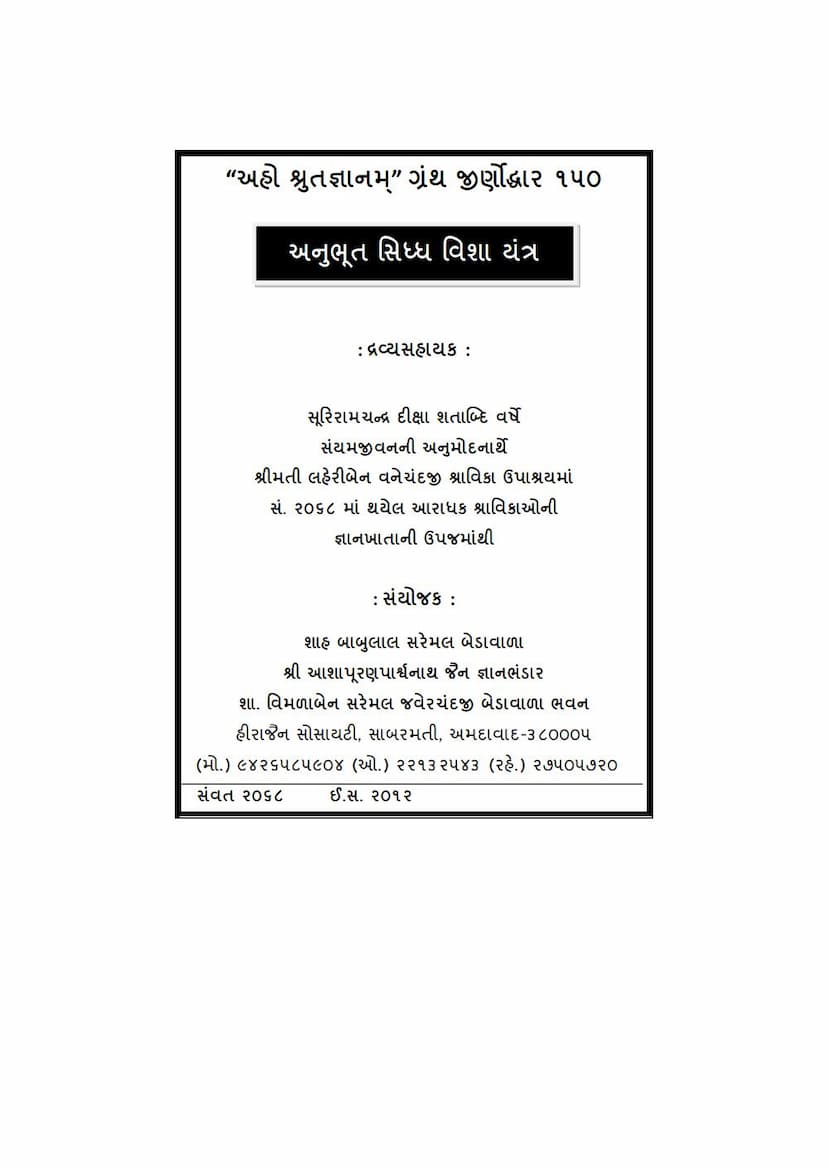Anubhutsiddh Visa Yantra
Added to library: September 1, 2025

Summary
Here's a comprehensive summary of the Jain text "Anubhutsiddh Visa Yantra" by Meghvijay, based on the provided pages:
Book Title: Anubhutsiddh Visa Yantra (also referred to as Anubhuta Siddha Vishayantra or Anubhut Siddh Vishayantra) Author: Meghvijay (specifically, Mahamahopadhyaya Shri Meghvijay Gani) Publisher: Mahavir Granthmala
Overall Purpose and Content:
"Anubhutsiddh Visa Yantra" is a Jain text compiled and authored by the esteemed Mahamahopadhyaya Shri Meghvijay Gani. The book is a collection of six specific "kalpas" (practices or rituals) related to potent "yantras" (mystical diagrams or instruments). The text, along with its translations and detailed explanations, aims to preserve and disseminate knowledge about these powerful yantras and their associated practices, which are believed to have various beneficial effects.
Key Components and Kalpas:
The book is presented as a collection of six significant kalpas, as indicated by the table of contents and the introduction:
-
Siddh Bissa: This appears to be the primary and most extensively detailed yantra in the collection. The introduction describes it as a yantra revealed to Meghvijay Gani in a dream by Goddess Padmavati. It is noted for its intricate construction, described as being made with the word "Aha" to form the "Bissa" and featuring various forms of the yantra, including tikshna, chokhana, and padmakara. The text emphasizes its efficacy in providing victory, success in business, and relief from ailments.
-
Yantra (Appendix No. 1): This section likely contains further details or variations of yantras.
-
Gahajual Tika: This refers to a commentary or explanation related to a yantra or practice named "Gahajual."
-
Gahajual Aamnay: This likely pertains to the tradition or lineage associated with the "Gahajual" practice.
-
Ugrveer: This kalpa is described as an empirically tested practice, whose efficacy is evident from its name. It is said to be effective in removing obstacles and poverty.
-
Dadashibavan Tola Poweratti: This kalpa is attributed to Dada Ji Shri Jindatt Surishwarji, a figure renowned for his contributions to Jainism. The text highlights its qualities aligning with its name and its experiential basis.
-
Jagat Shetji ka Chandrakalpa: This kalpa is attributed to the renowned Jagat Seth, who is said to have personally experienced its benefits. It is presented as a powerful practice.
Significance and Context:
The text belongs to the genre of Jain Tantra Shastra or esoteric practices, which involves the use of yantras, mantras, and rituals for spiritual and material benefits. The compilation by Meghvijay Gani is a testament to his scholarship and dedication to preserving these ancient traditions. The publication by Mahavir Granthmala signifies an effort to make these rare and often inaccessible texts available to a wider audience, possibly through digitization and reprinting. The introductory pages also indicate a mission to revive and promote lost or rare Jain knowledge ("shruta gnana").
Key Figures and Institutions:
- Mahamahopadhyaya Shri Meghvijay Gani: The author and compiler of the work.
- Shri Jinadatt Surishwarji: A revered Jain scholar and practitioner, whose works are referenced.
- Jagat Seth: A historical figure known for his wealth and spiritual pursuits, whose yantra is included.
- Goddess Padmavati: Mentioned as the revealer of the "Siddh Bissa" yantra.
- Shri Asha Puran Parshvanath Jain Gnana Bhandar: The institution responsible for the "Grath Jironoddhar" (restoration of old texts) and publication of this work.
- Shri Meghvijay Gani: His works are specifically noted for preservation and digitization efforts.
Overall Value:
"Anubhutsiddh Visa Yantra" serves as a valuable resource for scholars and practitioners interested in Jain esoteric traditions, yantra Shastra, and the practical applications of Jain philosophy for worldly and spiritual well-being. The book's preservation and dissemination by institutions like Shri Asha Puran Parshvanath Jain Gnana Bhandar ensure the continuity of this specialized knowledge within the Jain tradition.